Buddhist Pilgrimage at Sarnath Day 2
Posted by sky | Tags: Buddha, Buddhism, Buddhist-art, India, Personal, Photos, Sarnath, history, meditation, pilgrimage, respect, story
Buddhist pilgrimage 2008-10-26 photos at Sarnath, Varanasi.Varanasi is a holy city in Hinduism, being one of the most sacred pilgrimage places for Hindus of all denominations. According to legend, the city was founded by the Hindu deity, Shiva, around 5,000 years ago, thus making it one of the most important pilgrimage destinations in the country. Varanasi is generally believed to be about 3,000 years old. More than 1,000,000 pilgrims visit the city each year. Hindus believe that bathing in Ganga remits sins and that dying in Kashi ensures release of a person's soul from the cycle of its transmigrations.
Varanasi is one of the holiest places in Buddhism too, being one of the four pilgrimage sites Buddha had mentioned in Maha-parinibbana Sutta, that a pious person should visit and look upon with feelings of reverence. Ananda's Concern 15. "Formerly, Lord, on leaving their quarters after the rains, the bhikkhus would set forth to see the Tathagata, and to us there was the gain and benefit of receiving and associating with those very revered bhikkhus who came to have audience with the Blessed One and to wait upon him. But, Lord, after the Blessed One has gone, we shall no longer have that gain and benefit." Four Places of Pilgrimage 16. "There are four places, Ananda, that a pious person should visit and look upon with feelings of reverence. What are the four? 17. Lumbini: "'Here the Tathagata was born!' This, Ananda, is a place that a pious person should visit and look upon with feelings of reverence. 18. Buddhagaya: "'Here the Tathagata became fully enlightened in unsurpassed, supreme Enlightenment!' This, Ananda, is a place that a pious person should visit and look upon with feelings of reverence. 19. Sarnath: "'Here the Tathagata set rolling the unexcelled Wheel of the Dhamma!' This, Ananda, is a place that a pious person should visit and look upon with feelings of reverence. 20. Kusinara: "'Here the Tathagata passed away into the state of Nibbana in which no element of clinging remains!' This, Ananda, is a place that a pious person should visit and look upon with feelings of reverence. 21. "These, Ananda, are the four places that a pious person should visit and look upon with feelings of reverence. And truly there will come to these places, Ananda, pious bhikkhus and bhikkhunis, laymen and laywomen, reflecting: 'Here the Tathagata was born! Here the Tathagata became fully enlightened in unsurpassed, supreme Enlightenment! Here the Tathagata set rolling the unexcelled Wheel of the Dhamma! Here the Tathagata passed away into the state of Nibbana in which no element of clinging remains!' 22. "And whoever, Ananda, should die on such a pilgrimage with his heart established in faith, at the breaking up of the body, after death, will be reborn in a realm of heavenly happiness."
In Varanasi lies Sarnath, the site of the deer park where Buddha had given his first sermon of the Dharma. At the railway station, a group of porters helped to carry our luggages to our tour bus waiting outside the station. The porters piled the luggages on top of their heads in addition to carrying them with their hands. A small group of very young beggars and old beggars accompanied us as we waited for our luggages to board the bus. Along the way to our hotel (Meraden Grand Varanasi), we could see large green fields (quite a lot during the whole trip) along the road. The hotel is probably the most beautiful one among all the hotels we would stay during the trip. We would have our breakfast first before we checked into our rooms. Comparing to my usual breakfast in Singapore, I ate better breakfast and in much bigger portion for the whole trip as well. (I ate something very sweet here, didn't know what it was) Some of us had to wait for our rooms keys after our breakfast. I followed Vera to his room first so that I could charge my mobile phone, otherwise I could not take photos. There was a breakdown in his room toilet. Vera had a special role to perform in this trip, he was the assistant to our Venerable Mudita, just like the Venerable Ananda was a personal assistant to Buddha. Vera, who is a Thai, had been a monk before for a short time. I sit down and jot down the previous day events while waiting for my phone to be fully charged. Sita knocked on the door for she had come to deliver my room key. She was our group leader and also had to make sure we are all safe and sound. Time for bath. We had our lunch in another place, a restaurant. If my memory still serve me, I left a paratha uneaten as it was quite hard to chew. This was probably the only time I was wasteful on the food. We ate mostly vegetarian food for our whole trip other than eggs. Overall, the food we ate was quite good except that it could become monotonous for some people. I would appreciate very much that we had icecream during the trip and I had enjoyed each of them. Steven and I went out of the restaurant after we had finished our lunch. I was still eating my icecream. I was able to buy a pen at one of the shop to replace the pen that I had brought here. Hmmm, the shopkeeper told me to throw my icecream cup anywhere so I threw it along some rubbish beside the road.
Sarnath, located about six miles due north of the ancient city of Varanasi, is renowned as the place where the Buddha gave his first teaching. The name Sarnath derives from Saranganatha, which means Lord of the Deer. Once, in a previous life, the Buddha lived here as the leader of a herd of deer and offered his life to the king in return for his release of a pregnant doe. The king, amazed and humbled by this selfless action, created the Deer Park as a sanctuary for the deer. After Buddha's enlightenment, the Buddha went to the Deer Park of Sarnath to teach the Dharma to his five former companions: Kondañña, Bhaddiya, Vappa, Mahanama, and Assaji. In this first sermon known as Dharmacakra-pravartana (Dhammacakkappavattana Sutta), Turning the Wheel of the Dharma, the Buddha conveyed to his first five disciples the four noble truths, the eightfold path, and the twelve links of dependent origination. (On the No-self Characteristic) With their realization of the Buddha's teaching, the Sangha was established at this holy place. Since that time, Sarnath and the Deer Park have symbolized teaching and transmission of the Dharma.We would arrive at Sarnath. First, we visited the Dhamek Stupa, we circumambulated the Dhamek Stupa three times before taking our seats on the grass beside the Stupa to do our meditation. (When had I ever do meditation without feeling sleepy?) This was probably the first time I was not feeling sleepiness in meditation! , maybe bacause it was done outdoors and I was feeling the warmth and the heat from the Sun. :) Only a small portion of the Dhamek Stupa's facing stones survive today. (photo) The stone facing is chiseled and displays delicate floral carvings of Gupta origin. The wall is covered with exquisitely carved figures of humans and birds, as well as inscriptions in the Brāhmī script. Sitting on the grass, I was able to gaze at some of the drawings and carvings on the side of the stupa facing me and I noted one which is a flower shape containing a smaller flower shape. Only the Dhamek Stupa remains today, the Dharmarajika Stupa was completely destructed, only its foundation remains. (The Stupa was mined in 1794 for materials to build the Jagatganj marketplace) A local Indian guide explained that King Ashoka built the earlier stupas. King Ashoka built stupas to enshrine small pieces of calcinated bone and other relics of Buddha and his disciples. He had also erected many Ashoka pillars during his reign in the 3rd century BCE. It would be mainly due to him that we now had the opportunity to visit and pay our respect in these holy places. So, we had many many thanks to Buddha, his disciples, the Sangha, King Ashoka, and also many of the Kings who had protected Buddhism and such sacred sites, Sir Alexander Cunningham (a British archaeologist known as the father of the Archaeological Survey of India) who had identified and preserved such sacred sites, and the famous Buddhist pilgrims like Faxian and Xuanzang who had left great accounts of their pilgrimage and had help to spread Buddhism to the East, and many of the many others. It was of immense fortune that we would be able to witness the revival of Buddhism in India and for Buddhists all over the world to be able to come to the holy places of Buddha to pay homage to Buddha. Excavations revealed as many as four and five layers of buildings, monuments, and shrines built one over the other. In all, around thirty monasteries were found at this site. The ground plan of the monastery is similar to cave monasteries carved out of solid rock at Bagh and Ajanta. The Ashoka pillar that was erected next to the main shrine, was broken fairly close to the ground. The once 15 m high pillar was made of Chunar sand stone. It was once surmounted by the famous lion capital with four lions facing the four directions standing on top of a Dharma wheel. This capital had miraculously survived the fall and can now be seen in the Sarnath Archaeological museum. (It is also an excellent example of Mauryan art) Today, a representation of this lion capital appears on the official flag of India. The pillar bears three inscriptions, the earliest one was an edict carved in Brahmi script at Asoka's command, directing monks and nuns to refrain from causing dissension within the Sangha.
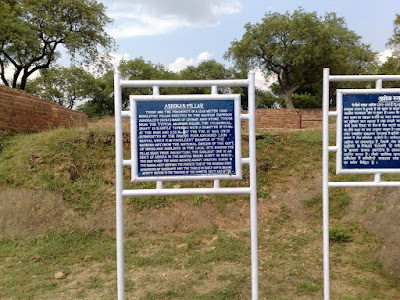
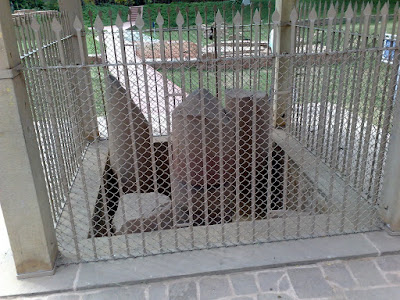
 About Dharmarajika Stupa
About Dharmarajika Stupa
 Sarnath map
Sarnath map
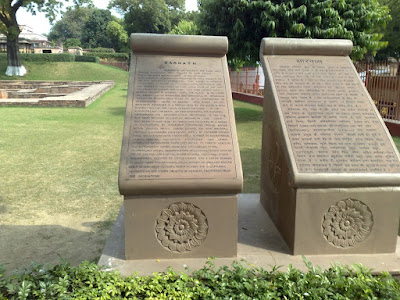 We would bypass the Chaukhandi mound (photo) without visiting it. The Chaukhandi monument is said to commemorate the reunion of the Buddha with his five former companions, who became his first five disciples. The building was erected during the Gupta period.
At Sarnath Archaeological Museum, we could see the magnificent Lion Capital of Asoka, it also houses a rich collection of sculptures, artifacts and edifices comprising numerous Buddha and Bodhisattva images and other ancient remains. The collection of figures and sculptures were from the Mauryan, the Kushana and the Gupta periods. Prominent of them is the earliest Buddha image found at Sarnath and many images of Hindu Gods dating from the 9th to 12th centuries. It also houses the famous Buddha statue in the Dharmacakra mudra (the teaching mudra) from the Gupta Period.
We next visited the new Mulagandhakuti Vihara, which was founded by Anagarika Dharmapala in 1931.
We would bypass the Chaukhandi mound (photo) without visiting it. The Chaukhandi monument is said to commemorate the reunion of the Buddha with his five former companions, who became his first five disciples. The building was erected during the Gupta period.
At Sarnath Archaeological Museum, we could see the magnificent Lion Capital of Asoka, it also houses a rich collection of sculptures, artifacts and edifices comprising numerous Buddha and Bodhisattva images and other ancient remains. The collection of figures and sculptures were from the Mauryan, the Kushana and the Gupta periods. Prominent of them is the earliest Buddha image found at Sarnath and many images of Hindu Gods dating from the 9th to 12th centuries. It also houses the famous Buddha statue in the Dharmacakra mudra (the teaching mudra) from the Gupta Period.
We next visited the new Mulagandhakuti Vihara, which was founded by Anagarika Dharmapala in 1931.
He was a leading figure in initiating two outstanding features of Buddhism in the twentieth century. He was a pioneer in the revival of Buddhism in India after it had been virtually extinct there for several centuries, and he was the first Buddhist in modern times to preach the Dharma in three continents: Asia, North America, and Europe. In 1891 Anagarika Dharmapala was on a pilgrimage to the recently restored Mahabodhi Temple, where the Buddha attained enlightenment at Bodh Gaya, India. Here he experienced a shock to find the temple in the hands of a Saivite priest, the Buddha image transformed into a Hindu icon and Buddhists barred from worship. As a result, he began an agitation movement. The Maha Bodhi society was founded in 1891. One of its primary aims was the restoration to Buddhist control of the Mahabodhi Temple at Bodh Gaya, the chief of the four ancient Buddhist holy sites. To accomplish this, Dharmapala initiated a lawsuit against the Brahmin priests who had held control of the site for centuries. After a protracted struggle, this was successful, with the partial restoration of the site to the management of the Maha Bodhi Society in 1949.The original Mulagandhakuti Vihara was built on the spot at Sarnath where the Buddha spent the first rainy season retreat with his disciples. Enshrined in the new Mulagandhakuti Vihara is a statue of the Buddha modeled after one of the statues unearthed at Sarnath, representing the Buddha in the Dharmacakra mudra, the gesture of teaching the Dharma. (the original statue is at the Sarnath museum) The temple has a magnificent large bell donated by the Maha Bodhi society of Japan; on the temple's walls are exquisite frescos depicting the life of the Buddha, painted by a Japanese artist. We circumambulated the Buddha statue three times as well and made some donations to the temple. There was a stall inside the temple near the entrance. Some books were sold there, but I did not have sufficient time to check out the books. On the way back to our hotel, when I was in the bus taking a photo on the street, I noticed a young Indian child smiling and waving at me; and so I smiled and waved back at him. After a short break at the hotel, we had some shopping at the Safari Silk Weaving Centre. Some of our fellow members bought quite a bit at this shop. Steven and I went out of the shop after a while. We would meet Sita, Vera, and the tour assistant later, they were trying out some boiled eggs at a street stall opposite the shop, and I would get invited to taste it. We would then visit an art centre that was selling buddha statues, jewels and other arts items. The price that they sold was expensive. I bought a small wooden buddha head that cost 270 rupees as a souvenir. I ended up being the last one to leave the centre. Alice congratulated me on buying the souvenir. Possibly, the only regret here was not going to visit the Ganges river. Initially, only three of us wanted to visit the Ganges river that was scheduled to be on the early morning on the next day. We had some chanting and meditation after our dinner at the hotel. Venerable Mudita had suggested that we should not go to the Ganges river for there is a bit of risk for the river here is toxic, and also because we would had a long journey to Lumbini. When he asked how many are going, I was the only one that put up my hand, I spotted that Vera half-raised his hand. In the end, I thought no one was going to the Ganges river tomorrow. (view others Varanasi photos) On the Buddha Trail in India from thezensite. My photos at the Mulagandhakuti Vihara.

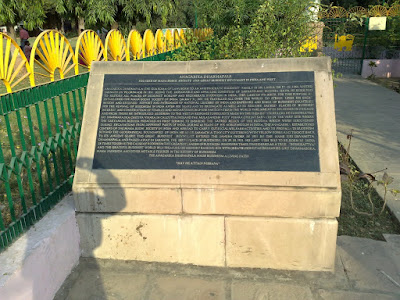

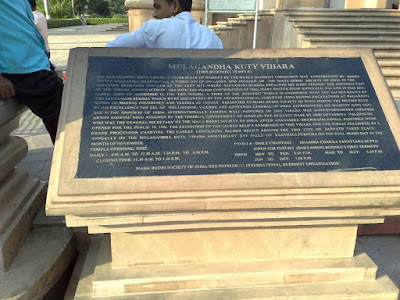

the Buddha statue in the Dharmacakra mudra
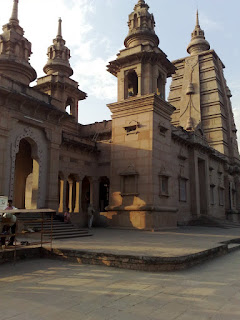 Huntington Archive of Buddhist and related art.
Buddhist art in the Freer and Sackler galleries.
Previous Post
Next Post
Huntington Archive of Buddhist and related art.
Buddhist art in the Freer and Sackler galleries.
Previous Post
Next Post